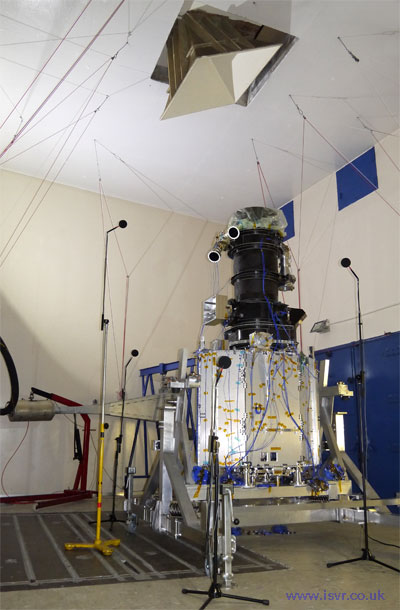High-intensity noise testing
Many aircraft and spacecraft components are exposed to high levels of noise-induced vibration at take-off and in flight. This can cause problems such as:

The SSTL 300 S1 Satellite SQM undergoing qualification testing in the Large Reverberation Chamber.
Photo used with permission of Surrey Satellite Technology Ltd.
- Failure of micro-electronic component lead wires
- Chafing of wires
- Cracking of printed circuit boards
- Malfunction or failure of waveguides or Klystron tubes
- Vibration of optical elements
- Failure of joints in structures made from composite materials.
To make sure components will not fail under this acoustic stress they are subjected to a high level noise field.
With spacecraft components, the stress occurs for a short time at take-off, typically one or two minutes. During testing the noise exposure is as close to real conditions as possible.
Aircraft components are more likely to be stressed for perhaps thousands of hours, so that real-time testing would be impracticable. In these cases accelerated testing is carried out with far higher noise levels but for much shorter test periods, typically one or two hours.
For spacecraft components the excitation spectrum is usually specific to the launch vehicle, but standard levels have been accepted for aircraft parts. These are specified in various documents, for example MIL-STD-810, or BS 3G 100. In either case overall levels of up to 160 dB may be required in various frequency ranges between 25 Hz and 10 kHz. Ceiling-mounted and suspended horns are used as high-intensity noise sources.
Levels of up to 147 dB can be generated in the Large Reverberation Chamber (348 cubic metres). In the Small Reverberant Chamber (131 cubic metres) levels of up to 160 dB can be attained, depending on the sound spectrum required.

